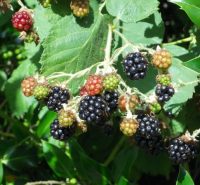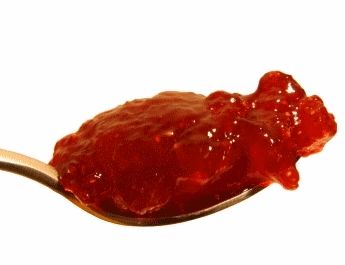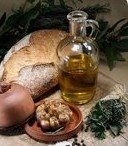Jam Recipes that are Easy to Make Plus Instructions on How to Make Great Jam
The difference between jam and conserve is that they both look the same, and they are both made in the same way, only conserve is made with 2 or more kinds of fruit and often has the addition of raisins or other dried fruit added to the mixture. Sometimes conserve recipes ask for nuts to be added too.
When making jam make sure that all your jam making equipment has been properly sterilized and your jam jars are thoroughly dry before you fill them.
To preserve your jams you can either pour a layer of hot parrafin-wax over the jam once in the jar. This is advisable if you live in damp climates. Or you can use a round of wax paper immersed in brandy and then placed on the jam before putting on the lid.
We hope you enjoy these recipes for jam making and find them easy to make, because they really are, once you get the hang of it!
JAM RECIPES for APPLE and BLACKBERRY JAM
1 kg cooking apples eg:Granny Smith
2/3 cup water
1/2 cup lemon juice
1 kg blackberries
2 kg sugar
Peel and core and slice the apples.
Method.—Put the apples into a large pot with the water and lemon juice and simmer for about 10 minutes or until tender.
Add the blackberries, and crush slightly. Add the sugar and cook, stirring constantly, over a low heat until the sugar is dissolved.
Bring to a boil and boil rapidly until the setting point is reached.
Continue as in the Basic Procedure, Steps 6 & 7.
JAM RECIPES for APRICOT JAM
1 kg of apricots, washed and stones removed
1 kg sugar
A few apricot kernels (optional)
Method.—Take the prepared fruit and place in alternative layers with the sugar in a large pot.
Heat slowly and stir occasionally until all the sugar has dissolved.
Continue as in the Basic Procedure, Steps 6 & 7.
If a few apricot kernels are added to the jam the flavor is improved.
JAM RECIPES for BLACKBERRY JAM
 Blackberries for Blackberry Jam
Blackberries for Blackberry Jam
1 kg blackberries
1/2 cup water
1/2 teaspoon citric or tartaric acid
1 kg sugar
Method.—Pick over berries and discard any that are rotten and rinse
Place in a pot and gently crush some berries to extract the juice.
Cook over a slow heat with the water and citric or tartaric acid, stirring all the time.
Add the sugar and continue as for the Basic Procedure, Steps 5, 6, and 7
JAM RECIPES for PEACH JAM
1 kg prepared fruit
About 1/2 - 1 1/4 cups water
1 kg sugar
Method.—Wash, dry, stone and cut peaches into halves. The removed stones should be placed into a muslin bag and tied off.
Put the fruit with the stones in the muslin back into a large pot and add 1/2 - 1 1/4 cups of water depending on the juiciness of the fruit.
Cook gently, stirring occasionally, until the fruit has softened.
Remove the muslin bag, add the sugar and continue as for the Basic Procedure, Steps 5, 6 & 7.
JAM RECIPES for PLUM JAM
1 kg prepared fruit
1/2 cup - 1 1/4 cup water
1 kg sugar
Method.—Wash, dry, stone and cut peaches into halves. The removed stones should be placed into a muslin bag and tied off.
Put the fruit with the stones in the muslin bag into a large pot and add 1/2 - 1 1/4 cups of water depending on the juiciness of the fruit.
Cook gently, stirring occasionally, until the fruit has softened.
Remove the muslin bag, add the sugar and continue as for the Basic Procedure, Steps 5, 6 & 7.
JAM RECIPES for STRAWBERRY JAM, RECIPE 1
(See video below for making old-fashioned strawberry jam.)1 kg strawberries, washed, dried and hulled
juice of 1 lemon
1 kg sugar
Method.—Place prepared fruit and lemon juice (adding no water) into a pot and cook over a medium heat until fruit has softened. Stir often.
Weigh the pulp. It should weigh about 700g. If it is more reduce the amount by further cooking.
Add the sugar and continue as in the Basic Procedure, Steps 5, 6 & 7.
Let the fruit remain in the pot for at least 20 minutes before pouring into the jars. This will prevent the fruit from rising to the top.
JAM RECIPES for STRAWBERRY JAM, RECIPE 2
3kg strawberries1 kg jam sugar
Method.—Take the stalks from the strawberries and put them in a preserving pan.
Stir and boil for thirty minutes over a moderate heat.
Add the sugar; stir and boil for about thirty minutes longer, or until the jam stiffens.
Remove all the scum as it rises.
Put the jam into tightly and cover tightly.
JAM RECIPES for RASPBERRY JAM
3 kg raspberries1 kg jam sugar
Method.—Remove the stalks from the raspberries and boil them over a moderate heat for fifteen minutes, stirring all the time.
Add the sugar, and boil for about thirty minutes longer, or until the jam will set.
Remove all the scum carefully.
Put the jam into jars and cover tightly.
JAM RECIPES for RHUBARB JAM
2.25 kg rhubarb2.25 kg jam sugar
Method.—Peel and cut the rhubarb as for a tart, put it in the pan with the sugar, and boil gently at first, then more quickly, skimming frequently.
When it sets it is ready.
JAM RECIPES for RED GOOSEBERRY JAM
1 kg jam sugar
Water
Method.—Take the heads and stalks from the gooseberries and put them in a pan, allowing a quarter of a pint of water to every pound of gooseberries.
Put the gooseberries into a preserving-pan.
Stir and boil for fifteen minutes.
Then add the sugar.
Continue stirring until the jam is set, skimming frequently.
Put it into jars and cover tightly.
JAM RECIPES for DAMSON JAM
Then put in the sugar broken into small pieces, and boil and skim for about twenty minutes longer, or until the jam will set.
Put into jars and cover tightly.
JAM RECIPES for BLACKCURRANT JAM
3 kg black currants1 kg jam sugar
Method.—Boil the fruit and sugar together until the jam will set, skimming all the time.
Put into jars and cover tightly.
What's the difference between Jams, Jellies and Marmalades?
With Jam Recipes your jam is made from both fruit juice and pieces of fruit and does not hold its shape but spreads easily without running.
With Jelly Recipes your jelly is made from fruit juice and is tender yet firm enough to hold its shape when turned out on a plate. It is usually clear and brightly colored.
With Marmalade Recipes your marmalade is made from citrus fruits of any kind. The peel of the fruit is included and shredded.
Each of these will be discussed in turn, with jelly recipes and marmalade recipes found on the other pages. See the links below to take you there. You will find jam recipes below and easy instructions on how to make jam.
HOW TO MAKE JAM in 8 EASY STEPS
Step 1. When beginning your jam recipes, wash and dry the fruit well and cut up if large, removing cores and stones if present.Step 2. Prepare the jars by first washing them in hot soapy water, rinse well and put them upside down on racks in a pre-heated oven at 130C for at least 30 minutes. This will sterilize the jars. Jars with plastic screw-type lids should be soaked in a solution of bleach and water. Shake them try before using.
Step 3. With your jam recipes cook the fruit in a large, uncovered pot with the minimum of water until just softened. Check for the pectin content if you are unsure.
Step 4. Measure the cooked pulp and add the appropriate amount of sugar. This is important for jam recipes. If you use jam sugar you don't have to use as much sugar as you would in other jam recipes calling for ordinary sugar.
Step 5. Return the pan to a medium heat and stir until the sugar has dissolved. The turn up the heat, bringing the jam to a boil, and boil rapidly until setting point has been reached.
Step 6. Skim off the froth or scum that forms while boiling and discard. Doing this will keep your jam clear. A little cooking oil added to the pan will also help get rid of the scum. After about 10 - 15 minutes of boiling, test for setting point.
To Test for Jam Setting:
Remove the pan from the heat. Put a couple of spoonfuls of jam onto a cold plate. Let this sit for a few minutes to cool. Lightly draw your fingertip across the surface of the jam. If it has formed a thin skin which wrinkles when you touch it, your jam will set.
Step 7. Pour the still hot jam into the clean, hot jars, leaving a 1/4 inch. Seal with plastic screw tops or dampened cellophane seals. Wipe the jam jars before storing and check that the lids are tight.
Step 8. Store in your pantry for a maximum of 6 months.
A GREAT TIP FOR YOUR JAM MAKING
One of the best tips I can give you when making your jam recipes is that for those fruits that are low in pectin, you can have no-fail jam by simply grating 1 large or 2 small carrots into any of your jams. Grate it on the fine side of the grater so that the pieces are fine and include all the juice. Your jams will set and you will never have a problem with your jam recipe not setting. Best of all, you cannot detect the presence of the carrot!
Extra Resources for your Jam Making:
Make Homemade Liquid PectinUSDA Home Canning Jams and Jellies
VIDEO ON HOW TO MAKE OLD-FASHIONED STRAWBERRY JAM VIDEO 1
VIDEO ON MAKING OLD-FASHIONED STRAWBERRY JAM PART 2
VIDEO ON MAKING OLD-FASHIONED STRAWBERRY JAM PART 3
RECOMMENDED BOOKS ON HOMEMADE JAM MAKING
You can Add your Jam Recipes!
We have lots of pages where you can contribute to throughout this website. We love hearing from our readers, and hope you will be one of those we hear from too. Look around our homesteading website. If you have some jam recipes of your own, please submit them. All you need to do is type and submit. We will do the rest!
Leave a Comment
Do you have anything that you would like to add after reading this page? We would love to hear your thoughts. If you can add additional information to what has been written here you will be adding value to the website! No need to have any special skills - just type and submit. We will do the rest!
Did you find this page helpful?
Sharing is a way of saying, "Thanks!"






New! Comments
Do you have something of value to add? Leave me a comment in the box below.